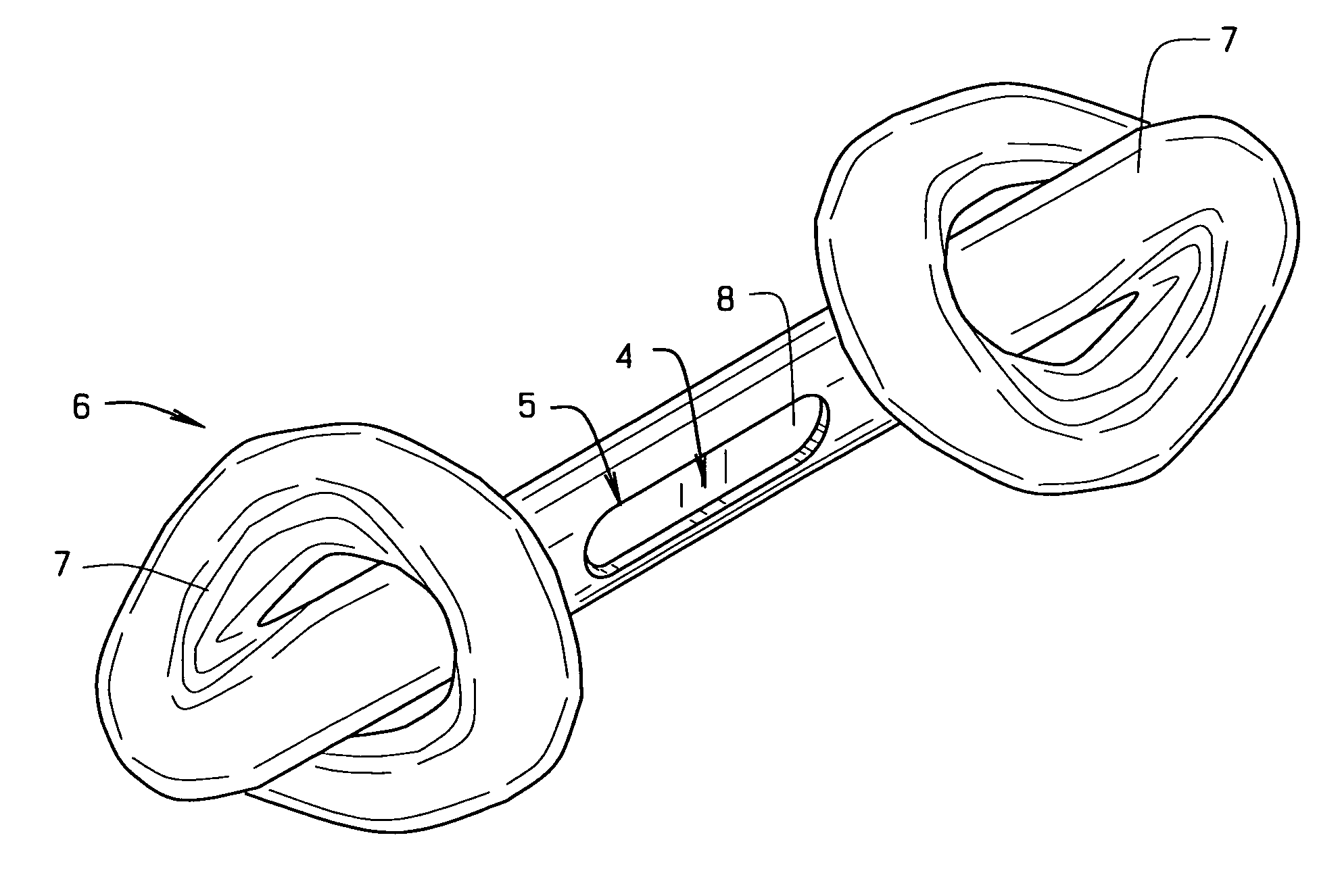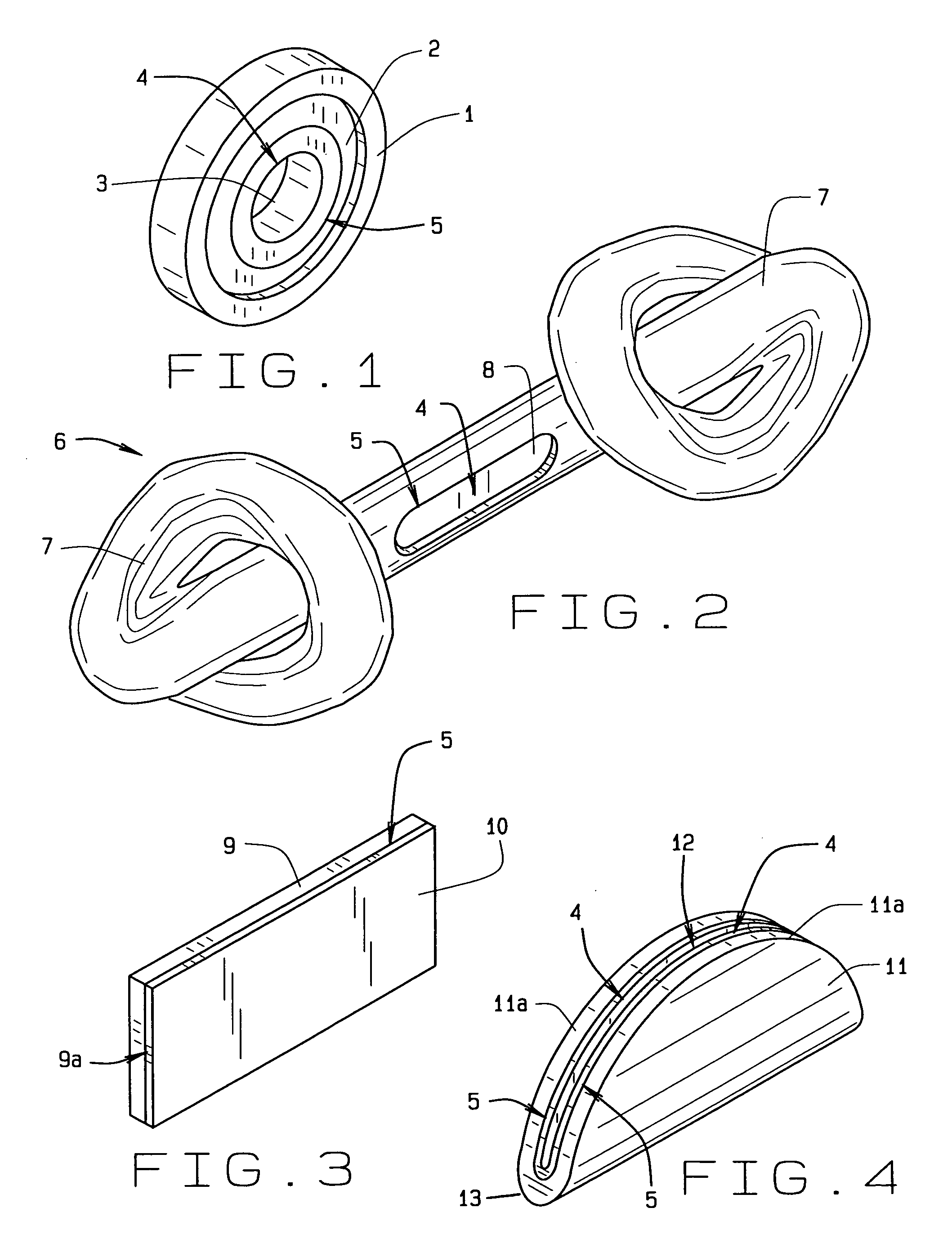Adhesion system for rawhide and meat chew for dogs
a technology of adhesive system and rawhide, which is applied in the field of adhesive system of rawhide and meat chew for dogs, can solve the problems of reducing the acceptability of this kind of chew to many dogs, reducing the amount of attraction and overall palatability of the companion animal, and the base rawhide is not particularly palatable to dogs. , to achieve the effect of maximum attraction and overall palatability, long-lasting chewing, and high-palatable chewing
- Summary
- Abstract
- Description
- Claims
- Application Information
AI Technical Summary
Benefits of technology
Problems solved by technology
Method used
Image
Examples
example 1
Rawhide Ring with Recessed Cavity Containing Chicken Meat
[0039]As shown in FIG. 1, a rawhide and chicken meat treat for dogs was manufactured by producing rawhide rings 1 with a circular cavity 2 inside the circumference of the ring. A layer of liquid milk protein hydrolysate was utilized to attach a chicken slurry inside the above described cavity.
[0040]A rawhide ring was produced from bleached shoulder hide fraction. A thick shoulder hide approximately 6 mm in thickness was die cut with a clicker to produce the outline shown in FIG. 1. The pieces were heated to approximately 110° F. to produce a formable product. The rawhide was then pressed on a reciprocating punch press to cut-out the center cavity and to form the rawhide into the shape shown in FIG. 1. The rawhide was then dried at 140° F. for 4 hours followed by a further dehydration at 190° F. for 6 hours.
[0041]The outside diameter of the ring was 2.75″. The hole or aperture 3 in the center of the ring was 1″ in diameter. The...
example 2
Knotted Rawhide with Chicken Filling
[0046]An alternative pet treat that can be made with the teachings of this invention shown in FIG. 2. This treat is a knotted rawhide shaped like a bone 6 with a cavity formed into the center of the bone shaped treat in which a milk protein hydrolysate adhesive, as previously described, is used to attach a chicken slurry. Utilization of the milk hydrolysate adhesive provides for a firm attachment of the chicken fraction and results in a longer chew time for the treat.
[0047]A bleached rawhide sheet of approximately 4 mm thickness from the stomach section of a cattle hide was sliced into rectangular patterns approximately 20″ by 7″. The product was then rolled very loosely to create a hollow area in the center of the wraps. The two ends were then each tied into a knot 7 and the rawhide treats were dehydrated for 4 hours at 140° F. This was followed by an additional dehydration step of 8 hours at 180° F. The knotted rawhide treats had an average over...
example 3
Rawhide Stick with Attached Beef Jerky
[0053]In this particular embodiment of the invention, the meaty fraction is formed and dried prior to the attachment to the rawhide component as shown in FIG. 3. The rawhide fraction was produced by taking bleached 5 mm splits from the cattle shoulder fraction and die cutting 6″×2″ strips, as at 9, utilizing a cutting machine known in the trade as a “clicker.” The strips which weighed an average of 60 grams wet were then dehydrated at 120° F. for 4 hours followed by 4 hours at 140° F. They were then dehydrated for an additional 4 hours at 180° F. At this point, the rawhide fractions had an average weight of 30 grams. By utilizing a lower temperature at the initial stage of the dehydration, the pieces did not curl and remained straight and flat which eased the eventual attachment of the dried meaty fraction. The drying cycle reduced the average length of the strips to 5 inches.
[0054]A beef jerky-style strip was produced by mixing together the fol...
PUM
 Login to View More
Login to View More Abstract
Description
Claims
Application Information
 Login to View More
Login to View More - R&D
- Intellectual Property
- Life Sciences
- Materials
- Tech Scout
- Unparalleled Data Quality
- Higher Quality Content
- 60% Fewer Hallucinations
Browse by: Latest US Patents, China's latest patents, Technical Efficacy Thesaurus, Application Domain, Technology Topic, Popular Technical Reports.
© 2025 PatSnap. All rights reserved.Legal|Privacy policy|Modern Slavery Act Transparency Statement|Sitemap|About US| Contact US: help@patsnap.com


